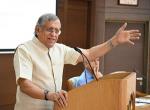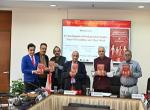On, Dr G. Satheesh Reddy, Secretary, Department of Defence and Chairman DRDO was invited for a talk on ‘Achievements in Defence Indigenization’ under the aegis of the Vivekananda International Foundation’s Vimarsha lecture series.
Dr Reddy has made significant contributions toward indigenous design, development and deployment of diversified missiles and strategic system, guided weapons, and avionic technologies. He has also significantly contributed towards the formulation of many other national policies and was pivotal in evolving road map for self-sufficiency in missiles. As the Director General of Missiles and Strategic Systems, he has spearheaded a number of critical programs, especially the Missile Complex Laboratories which includes Advance Systems Laboratory (ASL), Defence Research and Development Laboratory (DRDL) and Research Centre Imarat (RCI).
Dr Arvind Gupta, Director, VIF, began the session by welcoming Dr Reddy and congratulating him and his team of scientists for making India proud on 27 March 2019 after successfully conducting Anti-Satellite Test (ASAT). Dr Gupta thereafter enlightened the audience about the need and relevance of indigenization in defence sector.
While stressing the importance of indigenization in defence sector, Dr Gupta mentioned that 70 per cent of India’s armed forces requirements were still imported. Dependence on imports of defence equipment constitutes national security vulnerability. Indigenisation of defence equipment, are therefore, need of the hour. Anti-Satellite Missile Test (ASAT) conducted by the DRDO scientists has again highlighted the organization’s tremendous contribution to indigenization of defence technologies and production.
DRDO’s job is to design, develop and make prototype systems for the armed forces. DRDO has made great contributions in developing high technologies and strategic systems for the defence of the country. India is today self-reliant in its needs for different kinds of missiles, radars, electromagnetic weapon system, sonars, torpedo’s, communication system’s etc. Prithvi, Agni, Akash, Nag, Brahmos, etc. are today household names. This is largely due to the efforts of the DRDO.
India is one of the four nations that have successful ballistic missile defence capabilities. In recent years, indigenously made Arjun Tank and Lite Combat Aircraft have also been inducted in the armed forces. High profile achievements notwithstanding, there have been some gaps as well, particularly, in the making of the arms and ammunition, detectors, and several other platforms.
The DRDO has been successful in helping create an ecosystem for defence technology in the country. Many of India’s leading academic and scientific institutions are today working with the DRDO. Nearly 1200 industries are contributing for various DRDO’s programmes. Indeed India cannot rest on past laurels and much more needs to be done. The needs of the armed forces are growing. Large scale programs in hyper-sonic missiles, Unmanned Combat Aerial Vehicles (UCAV), Long range radars, robotic system etc. are needed.
New technologies like Artificial Intelligence, Machine Learning and Big Data Analytics need to be mastered. The country needs to also absorb the Industrial 4.0 Revolution. DRDO, industry and academia, all need to work in a collaborative mode to master these technologies, absorb them, and produce new products. India also needs to pay attention to the over-hauling its science technology, engineering, mathematics and innovation. In his keynote address, Dr Reddy highlighted key achievements of the DRDO, its future direction, and also briefly touched on the general ecosystem of indigenization taking roots in India.
He stressed that there are certain achievements that are worth mentioning. First, almost all the critical technologies that are required by the country are indigenously developed by the DRDO in collaboration with the industry. Second, all system that have been developed by the DRDO are functioning as per the design. Third, ‘hit-to-kill’ has been achieved against live satellite with accuracy less than 10 m which is on par with the best reported performance worldwide. Fourth, the ASAT mission was carefully designed with keeping in mind the range of safety measures and the resulting debris. Lastly, there has been an active participation from Indian industry in the concurrent mode.
Dr Reddy mentioned that in order to develop the industry and academia connect, a number of research centres have been established by the state. Also, there are research boards in all Indian defence services (army, air-force and navy). There are centres established by the DRDO in different institutions like IIT and Hyderabad University etc. For funding the industries producing defence related technologies the – Government Owned & Company Operated (GOCO) Model – is being followed by the government. Herein, DRDO establishes the infrastructure and the operating industry produces systems and supplies it back to the DRDO.
Dr Reddy gave certain suggestions in order to achieve more and better in the task of indigenization of defence. There is a need to look into the technologies that would be required beyond 5 or 10 years. By and large, India has been a technology follower until now. The role needs to change and India needs to become a technology leader by developing the same technology that the advanced nations are developing.
Dr Reddy emphasised on the need to have a ‘sustained quality’ which means that the almost all the products should have the same kind of technology and quality. In order to excel even more in the field of indigenization, Dr Reddy made some important suggestions: Academia and industry should work together; academia should be doing core research; and the R&D institutes (like DRDO) must be promoted to work on applied research and not just limit themselves to the development aspect of it. This should be done with the help of inputs coming from the academia. Industry, other than being the core production agency, has to do research and development in niche areas.
In India today, there are a number of industries which are doing their own research in a particular area and are supplying all over the world. If all the three pillars, i.e. DRDO, academia, and industry play their roles as defined above, then only will India be able to come out with state-of-art technologies with potential commercial benefits, he stressed.
Following in talk, Dr Reddy extensively interacted with audience during Q&A session.






Post new comment